Douglas C-47 Skytrain
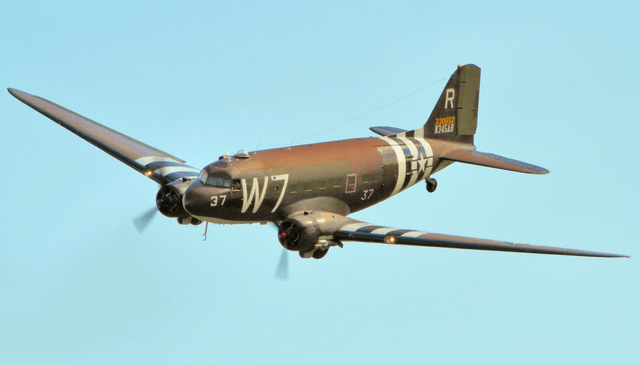
Douglas C-47 Skytrain

| C-47 Skytrain C-53 Skytrooper Dakota | |
|---|---|
| A C-47 over Duxford D-Day Show 2014 | |
| Role | Military transport aircraft |
| National origin | United States |
| Manufacturer | Douglas Aircraft Company |
| Designer | Douglas Aircraft |
| First flight | 23 December 1941[2] |
| Status | In service in Colombia, El Salvador and South Africa |
| Primary users | United States Army Air Forces Royal Air Force United States Navy Royal Canadian Air Force See operators |
| Number built | 10,174 |
| Developed from | Douglas DC-3 |
| Variants | Douglas XCG-17 Douglas AC-47 Spooky |
The Douglas C-47 Skytrain or Dakota (RAF, RAAF and RNZAF designation) is a military transport aircraft developed from the civilian Douglas DC-3 airliner. It was used extensively by the Allies during World War II and remains in front-line service with various military operators.[3]
| C-47 Skytrain C-53 Skytrooper Dakota | |
|---|---|
| A C-47 over Duxford D-Day Show 2014 | |
| Role | Military transport aircraft |
| National origin | United States |
| Manufacturer | Douglas Aircraft Company |
| Designer | Douglas Aircraft |
| First flight | 23 December 1941[2] |
| Status | In service in Colombia, El Salvador and South Africa |
| Primary users | United States Army Air Forces Royal Air Force United States Navy Royal Canadian Air Force See operators |
| Number built | 10,174 |
| Developed from | Douglas DC-3 |
| Variants | Douglas XCG-17 Douglas AC-47 Spooky |
Design and development
During World War II, the armed forces of many countries used the C-47 and modified DC-3s for the transport of troops, cargo, and wounded. The U.S. Naval designation was R4D. More than 10,000 aircraft were produced in Long Beach and Santa Monica, California and Oklahoma City, Oklahoma. Between March 1943 and August 1945, the Oklahoma City plant produced 5,354 C-47s.[3][6]
The specialized C-53 Skytrooper troop transport started production in October 1941 at Douglas Aircraft's Santa Monica plant. It lacked the cargo door, hoist attachment, and reinforced floor of the C-47. Only 380 aircraft were produced in all because the C-47 was found to be more versatile.
Operational history
World War II
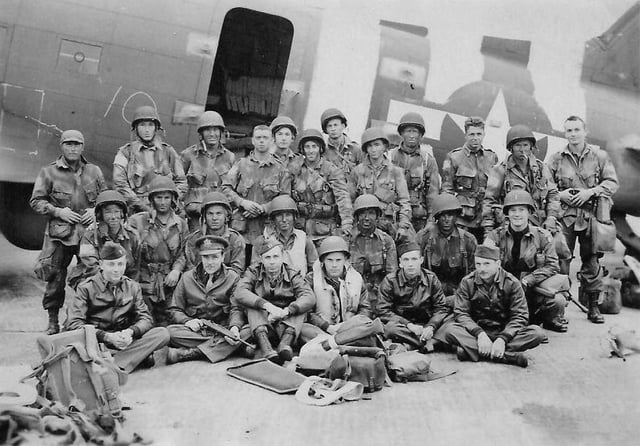
U.S. Army Pathfinders and USAAF flight crew prior to D-Day, June 1944, in front of a C-47 Skytrain at RAF North Witham
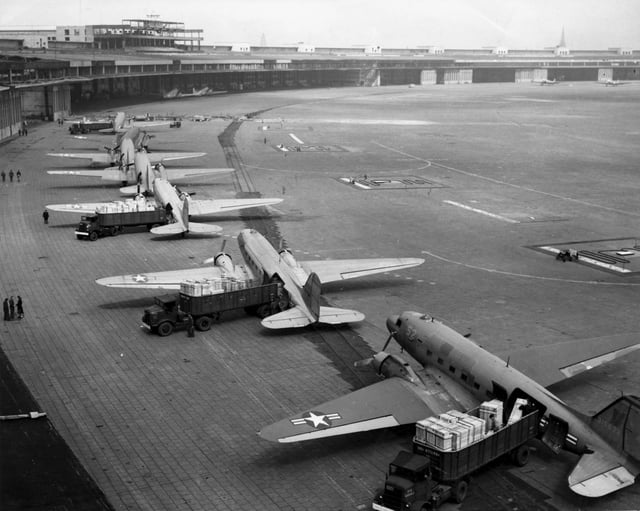
C-47s unloading at Tempelhof Airport during the Berlin Airlift
The C-47 was vital to the success of many Allied campaigns, in particular those at Guadalcanal and in the jungles of New Guinea and Burma, where the C-47 and its naval version, the R4D, made it possible for Allied troops to counter the mobility of the light-travelling Japanese Army. C-47s were used to airlift supplies to the encircled American forces during the Battle of Bastogne in Belgium. Possibly its most influential role in military aviation, however, was flying "The Hump" from India into China. The expertise gained flying "The Hump" was later used in the Berlin Airlift, in which the C-47 played a major role, until the aircraft were replaced by Douglas C-54 Skymasters.
In Europe, the C-47 and a specialized paratroop variant, the C-53 Skytrooper, were used in vast numbers in the later stages of the war, particularly to tow gliders and drop paratroops. During the invasion of Sicily in July 1943, C-47s dropped 4,381 Allied paratroops. More than 50,000 paratroops were dropped by C-47s during the first few days of the D-Day campaign also known as the invasion of Normandy, France, in June 1944.[7] In the Pacific War, with careful use of the island landing strips of the Pacific Ocean, C-47s were used for ferrying soldiers serving in the Pacific theater back to the United States.
About 2,000 C-47s (received under Lend-Lease) in British and Commonwealth service took the name "Dakota", possibly inspired by the acronym "DACoTA" for Douglas Aircraft Company Transport Aircraft.[8]
The C-47 also earned the informal nickname "gooney bird" in the European theatre of operations.[9] Other sources[10] attribute this name to the first aircraft, a USMC R2D—the military version of the DC-2—being the first aircraft to land on Midway Island, previously home to the long-winged albatross known as the gooney bird which was native to Midway.
Postwar era
The United States Air Force's Strategic Air Command had Skytrains in service from 1946 through 1967. The US Air Force's 6th Special Operations Squadron was flying the C-47 until 2008.
With all of the aircraft and pilots having been part of the Indian Air Force prior to independence, both the Indian Air Force and Pakistan Air Force used C-47s to transport supplies to their soldiers fighting in the Indo-Pakistan War of 1947.
After World War II, thousands of surplus C-47s were converted to civil airline use, some remaining in operation in 2012, as well as being used as private aircraft.
Vietnam War
Several C-47 variations were used in the Vietnam War by the United States Air Force, including three advanced electronic-warfare variations, which sometimes were called "electric gooneys" designated EC-47N, EC-47P, or EC-47Q depending on the engine used. Air International, Miami International Airport was a USAF military depot used to convert the commercial DC-3s/C-47s into military use. They came in as commercial aircraft purchased from third-world airlines and were completely stripped, rebuilt, and reconditioned. Long-range fuel tanks were installed, along with upgraded avionics and gun mounts. They left as first-rate military aircraft headed for combat in Vietnam in a variety of missions. [1] EC-47s were also operated by the Vietnamese, Laotian, and Cambodian Air Forces.[12] A gunship variation, using three 7.62 mm miniguns, designated AC-47 "Spooky", often nicknamed "Puff the magic dragon", also was deployed.[9]
Super DC-3 (R4D-8)
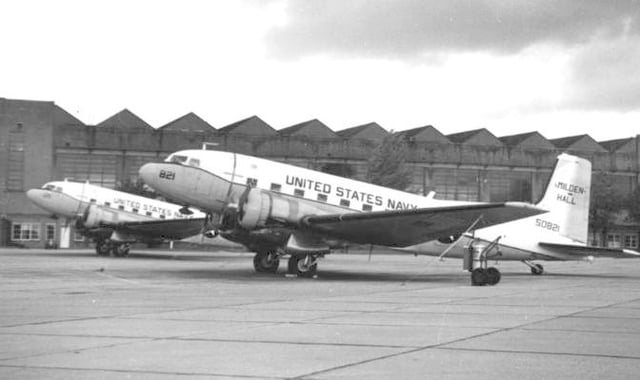
U.S. Navy C-117Ds at RAF Mildenhall in 1967
Large numbers of DC-3s and surplus C-47s were in commercial use in the United States in the 1940s. In response to proposed changes to the Civil Air Regulations airworthiness requirements that would limit the continuing use of these aircraft, Douglas offered a late-1940s DC-3 conversion to improve takeoff and single-engine performance. This new model, the DC-3S or "Super DC-3", was 39 in (0.99 m) longer. It allowed 30 passengers to be carried, with increased speed to compete with newer airliners. The rearward shift in the center of gravity led to larger tail surfaces and new outer, swept-back wings. More powerful engines were installed along with shorter, jet ejection-type exhaust stacks. These were either 1,475 hp (1,100 kW) Wright R-1820 Cyclones or 1,450 hp (1,081 kW) Pratt & Whitney R-2000 Twin Wasps in larger engine nacelles. Minor changes included wheel-well doors, a partially retractable tailwheel, flush rivets, and low-drag antenna. These all contributed to an increased top speed of 250 mph (400 km/h; 220 kn). With greater than 75% of the original DC-3/C-47 configuration changed, the modified design was virtually a new aircraft.[13] The first DC-3S made its maiden flight on 23 June 1949.[14]
The changes fully met the new FAR 4B airworthiness requirements, with significantly improved performance. However, little interest was expressed by commercial operators in the DC-3S. It was too expensive for the smaller operators that were its main target; only three were sold to Capital Airlines. The U.S. Navy and U.S. Marine Corps had 100 of their R4D aircraft modified to Super DC-3 standards as the R4D-8, later redesignated the C-117D.[15]
Variants
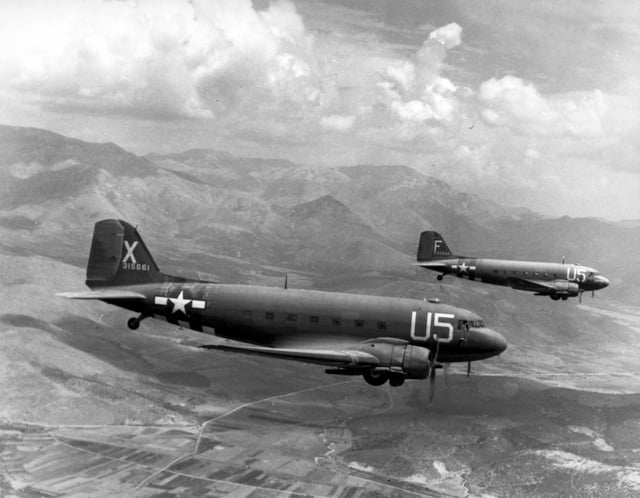
Paratroop C-47, 12th Air Force Troop Carrier Wing, invasion of southern France, 15 August 1944
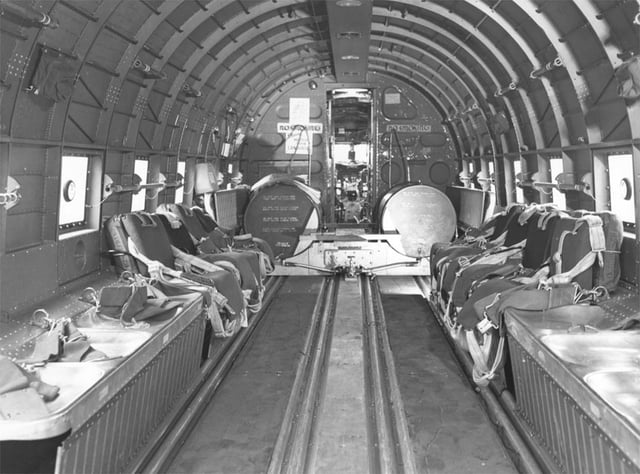
Interior view of Douglas C-47, Hendon Aerodrome, England

Aircraft of the 6th Special Operations Squadron including a C-47T in use by the U.S. Air Force, c. 2005
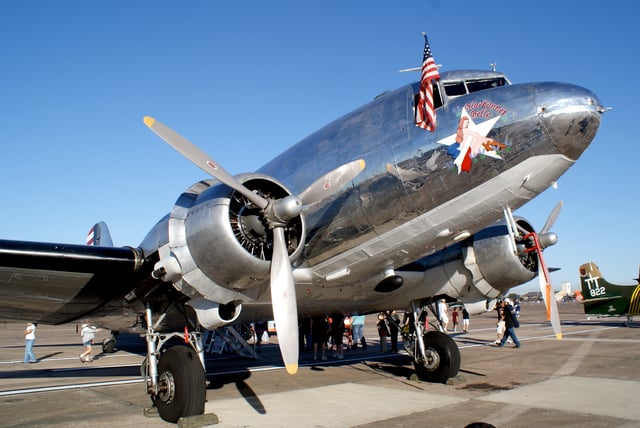
C-47B Skytrain -serial 43-49942
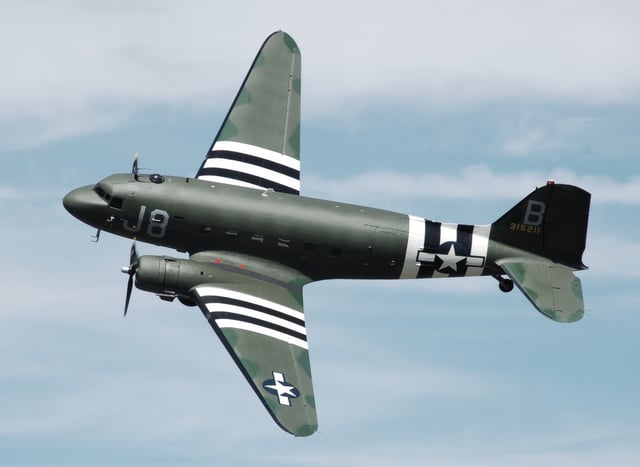
A former USAAF C-47A Skytrain which flew from a base in Devon, England, during the D-Day Normandy invasion and shows "invasion stripes" on her wings and fuselage
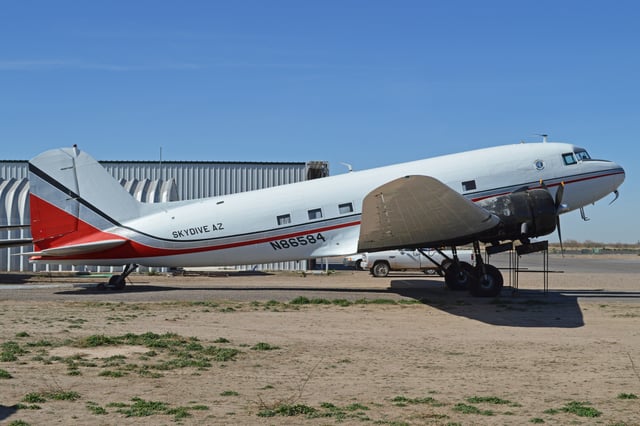
Douglas C-53 Skytrooper, c/n 4935, operated by a skydiving service at Eloy, Arizona
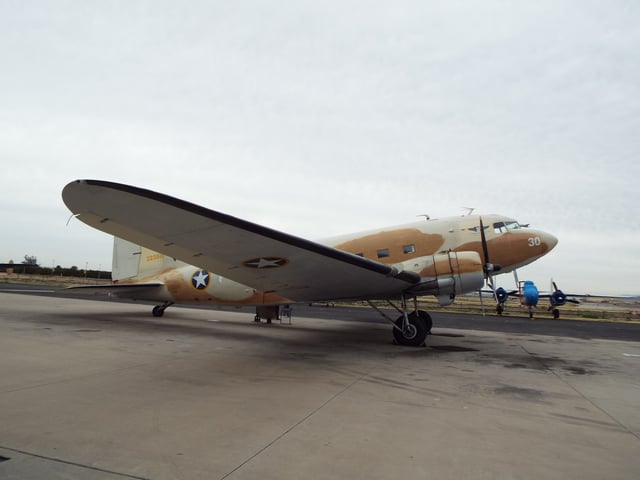
Douglas C-47 Skytrain Dakota “Old Number 30”
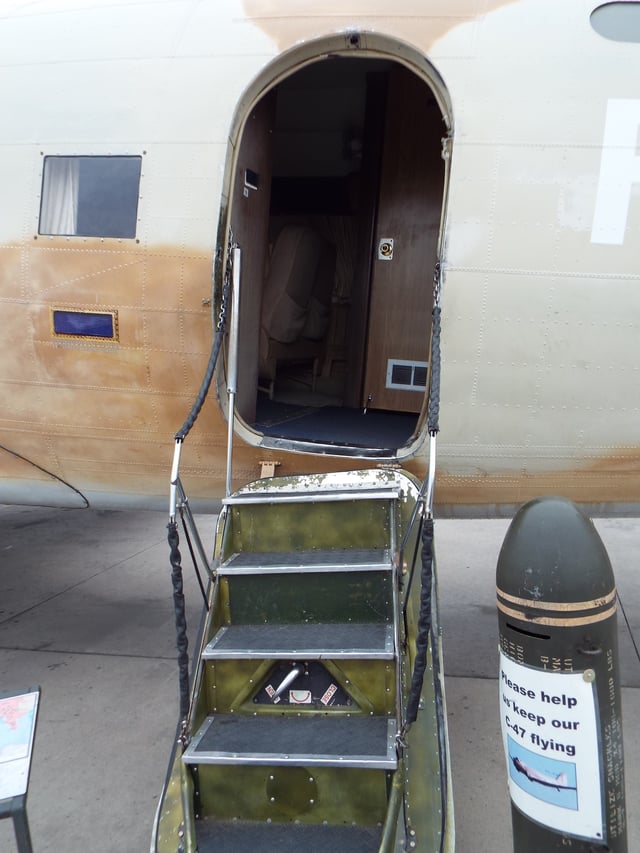
Douglas C-47 Skytrain Dakota “Old Number 30” door
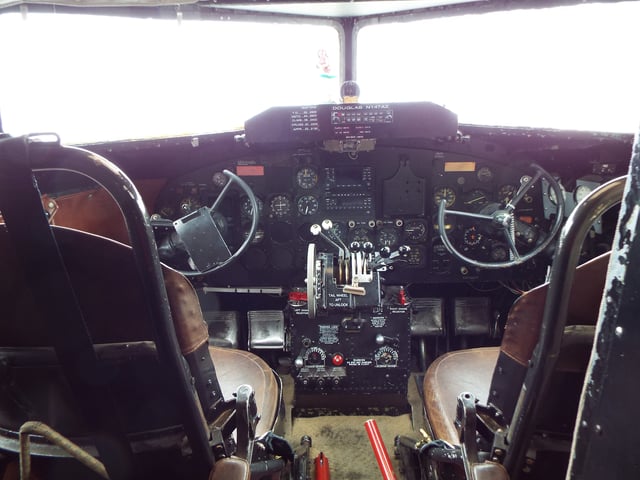
C-47 Skytrain cockpit
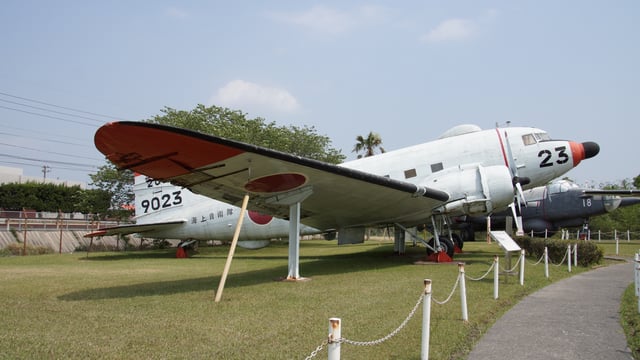
JMSDF R4D-6Q
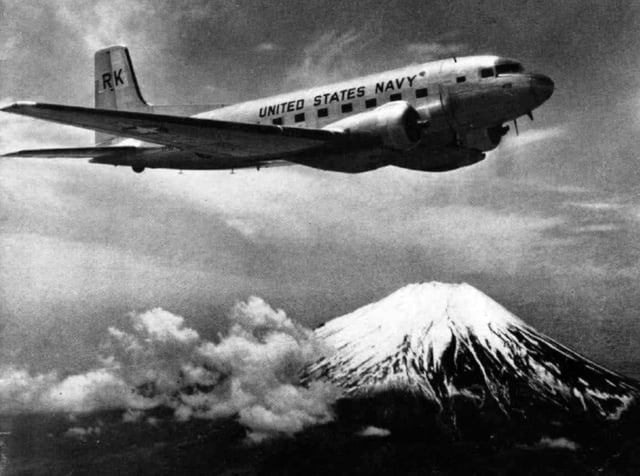
USN R4D-8 from VR-23 Codfish Airline over Mount Fuji, 1952
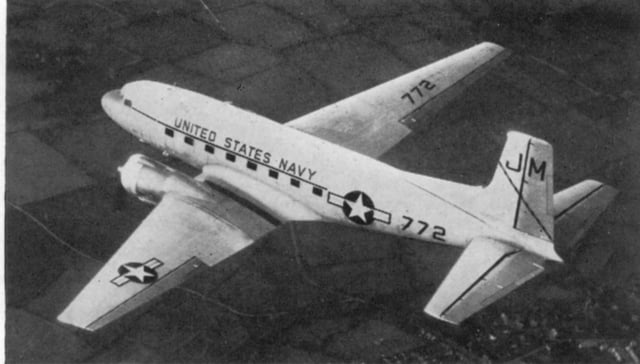
United States Navy R4D-8
- C-47Initial military version of the DC-3 with four crew (Pilot, Co-Pilot, Navigator, and Radio Operator) and seats for 27 troops alongside the fuselage interior. "Aerial Ambulances" fitted for casualty evacuation could carry 18 stretcher cases and a medical crew of three. 965 built (including 12 for the United States Navy as R4D-1).C-47AC-47 with a 24-volt electrical system, 5,254 built including USN aircraft designated R4D-5RC-47AC-47A equipped for photographic reconnaissance and ELINT missionsSC-47AC-47A equipped for Search Air Rescue; redesignated HC-47A in 1962VC-47AC-47A equipped for VIP transport roleC-47BPowered by R-1830-90 engines with two-speed superchargers (better altitude performance) to cover theChina
- R4D-6
- 157 C-47Bs transferred to USN; redesignated C-47J in 1962
- R4D-6L, Q, R, S, and ZVariants as the R4D-5 series; redesignated LC-47J, EC-47J, TC-47J, SC-47J, and VC-47J respectively in 1962R4D-744 TC-47Bs transferred from USAF for use as a navigational trainer; redesignated TC-47K in 1962R4D-8R4D-5 and R4D-6 remanufactured aircraft with stretched fuselage,Wright R-1820engines, fitted with modified wings and redesigned tail surfaces; redesignated C-117D in 1962R4D-8LR4D-8 converted for Antarctic use, redesignated LC-117D in 1962R4D-8TR4D-8 converted as crew trainers, redesignated TC-117D in 1962R4D-8ZR4D-8 converted as a staff transport, redesignated VC-117D in 1962
RAF designations
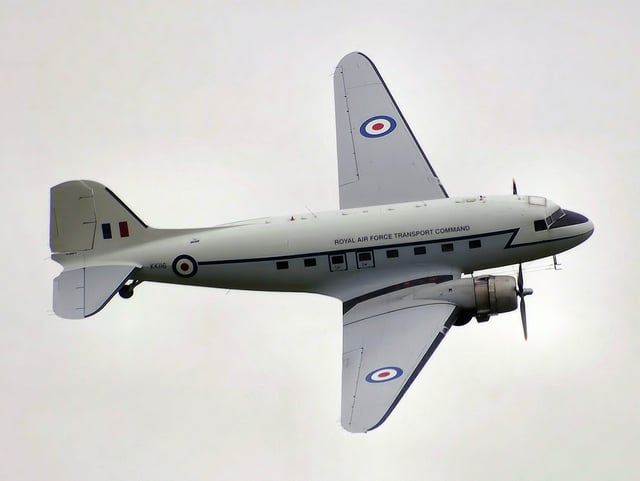
A Dakota IV in RAF Transport Command colors, owned by the Classic Air Force, operating out of Coventry Airport
- Dakota IRAF designation for the C-47 and R4D-1.Dakota IIRAF designation for nine C-53 Skytroopers received under the lend lease scheme. Unlike the majority of RAF Dakotas, these aircraft were therefore dedicated troop transports, lacking the wide cargo doors and reinforced floor of the C-47.Dakota IIIRAF designation for the C-47A.Dakota IVRAF designation for the C-47B.Airspeed AS.61Conversion of Dakota I aircraftAirspeed AS.62Conversion of Dakota II aircraftAirspeed AS.63Conversion of Dakota III aircraftBEA Pionair/Dart-DakotaConversion of Dakota toRolls-Royce Dartpower and used byBEAto prove turboprop engines prior to entry into service ofVickers Viscount. [18]
Aftermarket conversions
Operators
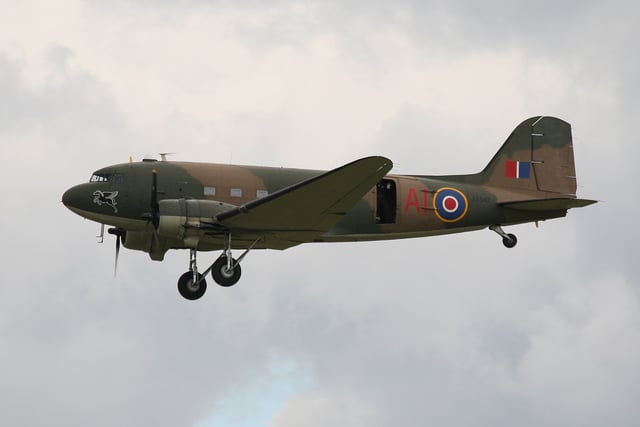
A Battle of Britain Memorial Flight Dakota with open parachute door at Duxford in 2008
Argentina
Australia
Biafra
Bangladesh
Brazil
Cambodia
Canada[19]
Chad
Chile
Republic of China
Colombia
[[INLINE_IMAGE|//upload.wikimedia.org/wikipedia/commons/thumb/6/6f/Flag_of_the_Democratic_Republic_of_the_Congo.svg/20px-Flag_of_the_Democratic_Republic_of_the_Congo.svg.png|//upload.wikimedia.org/wikipedia/commons/thumb/6/6f/Flag_of_the_Democratic_Republic_of_the_Congo.svg/31px-Flag_of_the_Democratic_Republic_of_the_Congo.svg.png 1.5x, //upload.wikimedia.org/wikipedia/commons/thumb/6/6f/Flag_of_the_Democratic_Republic_of_the_Congo.svg/40px-Flag_of_the_Democratic_Republic_of_the_Congo.svg.png 2x|Democratic Republic of the Congo|h15|w20|thumbborder flagicon-img flagicon-img]] DR Congo
Cuba
Denmark
Ecuador
Finland
Greece
Guatemala
Haiti
Honduras
Iceland
India
Indonesia
[[INLINE_IMAGE|//upload.wikimedia.org/wikipedia/commons/thumb/f/fd/State_flag_of_Iran_%281964%E2%80%931980%29.svg/25px-State_flag_of_Iran_%281964%E2%80%931980%29.svg.png|//upload.wikimedia.org/wikipedia/commons/thumb/f/fd/State_flag_of_Iran_%281964%E2%80%931980%29.svg/38px-State_flag_of_Iran_%281964%E2%80%931980%29.svg.png 1.5x, //upload.wikimedia.org/wikipedia/commons/thumb/f/fd/State_flag_of_Iran_%281964%E2%80%931980%29.svg/50px-State_flag_of_Iran_%281964%E2%80%931980%29.svg.png 2x|State flag of Iran (1964–1980).svg|h14|w25]] Iran
Israel
Jordan
[[INLINE_IMAGE|//upload.wikimedia.org/wikipedia/commons/thumb/2/22/Flag_of_Laos_%281952-1975%29.svg/23px-Flag_of_Laos_%281952-1975%29.svg.png|//upload.wikimedia.org/wikipedia/commons/thumb/2/22/Flag_of_Laos_%281952-1975%29.svg/35px-Flag_of_Laos_%281952-1975%29.svg.png 1.5x, //upload.wikimedia.org/wikipedia/commons/thumb/2/22/Flag_of_Laos_%281952-1975%29.svg/45px-Flag_of_Laos_%281952-1975%29.svg.png 2x|Laos|h15|w23|thumbborder flagicon-img flagicon-img]] Laos
Libya
Morocco
Netherlands
Nicaragua
Northern Rhodesia[21]
Oman
Pakistan
Panama
Peru
Philippines
Poland
Portugal
Rhodesia
Romania
Soviet Union (also as Lisunov Li-2)
Spain
Sweden
Singapore
Syria
Tanzania
Thailand
Togo
Turkey
Uruguay
Venezuela
Vietnam
South Vietnam
Yemen
Zaire
Zambia[21]
Accidents and incidents
Surviving aircraft
Large numbers of C-47s, C-117s and other variants survive, on display in museums or as monuments; operated as warbirds; or remaining in service.
As part of the D-Day 75th-anniversary commemoration in June 2019, 14 American C-47s (including That's All, Brother, Betsy's Biscuit Bomber, Miss Montana, Spirit of Benovia, D-Day Doll and N47E Miss Virginia [22]), and another group of 'Daks' from Europe retraced the route across the English Channel to Normandy taken by roughly 850 of these aircraft on D-Day.[23][24]
Specifications (C-47B-DK)
Data from McDonnell Douglas aircraft since 1920 : Volume I[25]
General characteristics
Crew: 4 (pilot, co-pilot, navigator, radio operator)
Capacity: 28 troops
Length: 63 ft 9 in (19.43 m)
Wingspan: 95 ft 6 in (29.11 m)
Height: 17 ft 0 in (5.18 m)
Wing area: 987 sq ft (91.7 m2)
Empty weight: 18,135 lb (8,226 kg)
Gross weight: 26,000 lb (11,793 kg)
Max takeoff weight: 31,000 lb (14,061 kg)
Powerplant: 2 × Pratt & Whitney R-1830-90C Twin Wasp 14-cylinder air-cooled radial piston engines, 1,200 hp (890 kW) each
Propellers: 3-bladed constant-speed propellers
Performance
Maximum speed: 224 mph (360 km/h, 195 kn) at 10,000 ft (3,000 m)
Range: 1,600 mi (2,600 km, 1,400 nmi)
Ferry range: 3,600 mi (5,800 km, 3,100 nmi)
Service ceiling: 26,400 ft (8,000 m)
Time to altitude: 10,000 ft (3,000 m) in 9 minutes 30 seconds
Wing loading: 26.3 lb/sq ft (128 kg/m2)
Power/mass: 0.0926 hp/lb (0.1522 kW/kg)
See also
Related development
Basler BT-67
Douglas AC-47 Spooky
Douglas DC-3
Douglas XCG-17
Lisunov Li-2
Showa/Nakajima L2D
Aircraft of comparable role, configuration and era
Curtiss C-46 Commando
Junkers Ju 52/3m
Related lists
List of aircraft of World War II
List of military aircraft of the United States
List of military aircraft of the United States (naval)
List of non-carrier aircraft flown from aircraft carriers
